Sunday, July 02 2017
MIPS Members / Followers:
We sent out our 2017 Blog/Survey on 6/28/2017 (see "Previous Blog" below), and the results have come in. Thanks to our loyal members, we had good participation.
As we all know (and what we pointed out in the Blog below), is that Bull Markets happen when the "Things" that are happening in the world (or at least in the USA) are good for corporate earnings (like the Fed's easing in 2008-2014, the Trump agenda in 2016, etc). Conversely, Bear Markets happen when "Things" that are anti-that above (like overbought markets, Trump's agenda failing, war with North Korea, etc.) come into play.
In the Survey we asked our members to provide us with their opinion of where the stock market would be at the end of:
(a) the next six months of 2017 and
(b) the first 6 months of 2018.
The categories that we defined were:
#1) Grow greater than +15%
#2) Grow between 0% and +15%
#3) Fall between 0% and -15%
#4) Fall between -15% and -30%
#5) Fall more than -30%
A summary of the SURVEY "votes" is shown below:

As can be seen above, in 2017 over two-thirds (69%) of our members think that the market will be somewhat bullish thru year-end; whereas in 2018 the consensus flipped to where almost two-thirds (64%) of our members are "bearish" by the end of the first six months. More dramatic is that only 6% felt like the market would undergo a significant drop by Dec'17; but 53% predicted a big drop by June'18. As probably known by most, the most common concern in the next 12 months is the timing of Trump's agenda.
MIPS IN DOWN MARKETS !!!
Interesting numbers, but MIPS members should "hope for" a big drop sometime in this 12-month period. Why? Because MIPS is designed to make money in down markets as well as in up markets (actually better in down markets).
Need proof?
The graph below shows the actual performance of our MIPS3 model between Oct 2007 - June 2009
- trading SPY long/short (no leverage)
- results "verified" by TimerTrac.com
From TimerTrac.com...
"Red dots" are actual trades
- MIPS3 is the Blue Line
- SPY is the Red Line
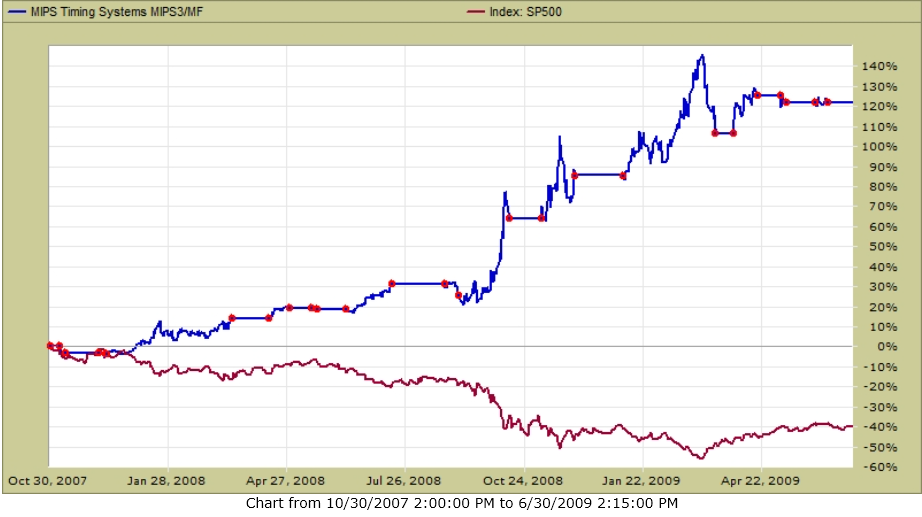
Paul Distefano, PhD
MIPS Timing Systems, LLC
Houston, TX
281-251-MIPS(6477)
support@mipstiming.com
=============================================================
<<< Previous Blag >>>
6/28/2017
MIPS - Back Away to see the market in "Full View" - SURVEY
MIPS Members / Followers:
- please take 2 minutes and complete the SURVEY at the end of this email...
I am sure that all of you have heard the expression "Sometimes we can't see the forest for the trees". Of course, this implies that in a thick forest one can only see 20-30 feet in any direction, and hence they have no idea what there is beyond that. So, if a stranger was in the middle of a forest in a horrific fire, they would most likely think that this fire could consume many homes and even some small towns. Hence, they would probably do everything that they could to alert the authorities in the area.
However, if the person was in a "forest" that was only 50 yards wide in each direction, surrounded by 100's of acres of just grass/weeds, then this forest fire would not be a threat to anyone except the stranger in the fire. Of course, another person in a small plane could immediately see the small size of the "forest" and completely understand that the fire was really no big deal.
Along this line, many people get bogged down in the very latest movements in the market without understanding how the market got where it is and what the underlying factors/movements mean. With this only info, they have almost no significant data to help them understand where the market is going from here and when.
Like many other things in life (like the guy in the small plane above), sometimes we have to back away and take a look at what we are analyzing from a longer-term view.
In the two graphs below:
- Graph #1 is a daily graph for the last four months (Mar-June 2017), and
- Graph #2 is monthly graph going all the way back to 1997
GRAPH #1
In the graph immediately below, the straight black line is the long-term trend line, and
the gray, green, red, orange and blue lines are EMAs:
- the grey line is the 18-day EMA,
- the green line is the 50-day EMA,
- the red line is the 100-day EMA,
- the orange line is the 150-day EMA, and
- the blue line is the 200-day EMA
What we can see from this is:
(a) The trend is going up "slowly", but may be getting weaker (market below trend in late-June)
(b) The moving averages:
- are moving almost perfectly "in sync" with each other,
- are keeping their individual "slopes", and
- are not getting weaker or converging with each another.
(c) The two observations above are bullish, but the market appears to be flattening out (bearish)
Read on...
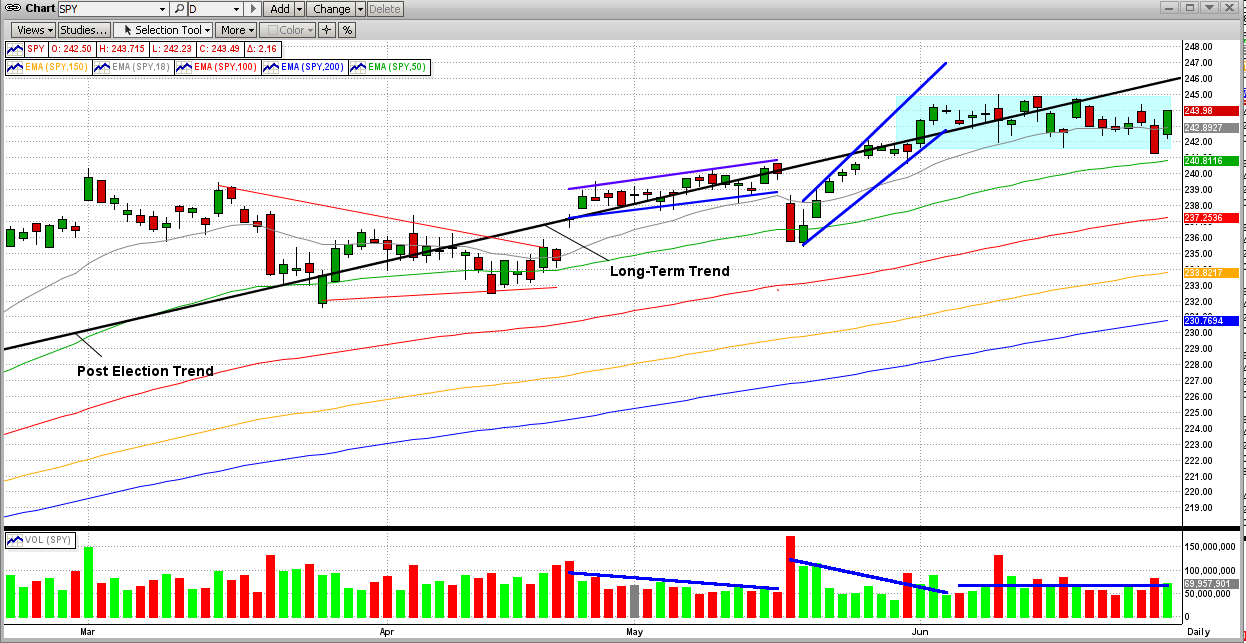
GRAPH #2
There is not enough in the above to make me feel comfortable, so lets "back away" and look at the market from a longer-term view. The view below covers almost 20 years (1997-June'07) and, of course, it contains the big market crashes in 2000 and 2008.
Read on...
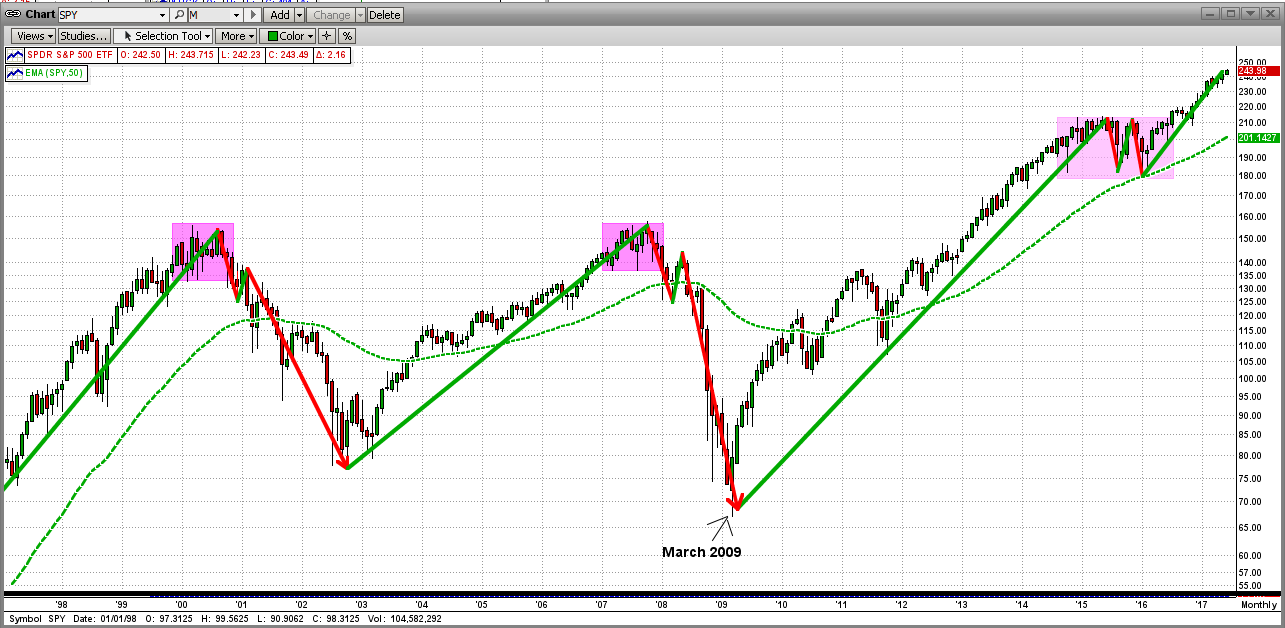
As you may know, real bear markets do not just happen immediately and out of the clear-blue sky. Two things are usually required: bad economic fundamentals and a "catalyst" to bring it about (like the Lehman Brothers failure, etc). Bear markets do not happen when the economy is booming. Stock prices go in the same directon as profits, period. That is, stock prices rise with increasing profits and stock prices fall with decreasing profits.
But stock prices "lead" in this relationship, as the very largest investment firms (Goldman Sachs, Morgan Stanley, etc) start selling before bad earnings numbers are realized and announced to the world of investors. Did you ever wonder how these big guys (aka Fat Kats) know when American companies are going to announce lower earnings (yeah, what a surprise). Maybe, just maybe, it is because these big American companies are their customers and somehow the fat kats figure it out (haha) at our expense.
At any rate, in Graph #2 above, it can be seen that what I call "topping" takes 9-15 months to complete a "turn-over", and then a catalyst comes along and takes the bottom out. The toppings in 2000 and 2008 were almost identical, and it appeared that the topping in 2015 (fake) would occur again. But it did not, thanks to the Presidential election; which sort of acted like an "anti-catalyst". This was because of the strong probability that Trump would strengthen the economy (lowering taxes, infrastructure spending, renegotiating or leaving foreign agreements, etc.). Now, if that fails, this "anit-catalyst" could become the catalyst for a big drop.
Of course, anything could happen from here...
- and that is why we need MIPS...
- MIPS is 1,000 times more complex and accurate than the simple analysis herein.
SURVEY
- WHAT DO YOU THINK???
We are asking all MIPS Members and followers to submit their opinions in an email reply, and we will share the results with all.
What is your opinion regarding market performance (S&P 500) in the next 12 months?
- please send us your best guesses for 12/31/2017 and 6/30/2018
------------------------------------------------Pick one for each year
Performance.......................................Dec 2017....June 2018
#1) Grow greater than +15%
#2) Grow between 0% and +15% x
#3) Fall between 0% and -15%
#4) Fall between -15% and -30% x
#5) Fall more than -30%
Example Answer................................. #2 for Dec'17 #4 for June'18
Thanks
Best Wishes...
Paul Distefano, PhD
MIPS Timing Systems, LLC
Houston, TX
281-251-MIPS(6477)
support@mipstiming.com
Wednesday, June 28 2017
MIPS Members / Followers:
- please take 2 minutes and complete the SURVEY at the end of this email...
I am sure that all of you have heard the expression "Sometimes we can't see the forest for the trees". Of course, this implies that in a thick forest one can only see 20-30 feet in any direction, and hence they have no idea what there is beyond that. So, if a stranger was in the middle of a forest in a horrific fire, they would most likely think that this fire could consume many homes and even some small towns. Hence, they would probably do everything that they could to alert the authorities in the area.
However, if the person was in a "forest" that was only 50 yards wide in each direction, surrounded by 100's of acres of just grass/weeds, then this forest fire would not be a threat to anyone except the stranger in the fire. Of course, another person in a small plane could immediately see the small size of the "forest" and completely understand that the fire was really no big deal.
Along this line, many people get bogged down in the very latest movements in the market without understanding how the market got where it is and what the underlying factors/movements mean. With this only info, they have almost no significant data to help them understand where the market is going from here and when.
Like many other things in life (like the guy in the small plane above), sometimes we have to back away and take a look at what we are analyzing from a longer-term view.
In the two graphs below:
- Graph #1 is a daily graph for the last four months (Mar-June 2017), and
- Graph #2 is monthly graph going all the way back to 1997
GRAPH #1
In the graph immediately below, the straight black line is the long-term trend line, and
the gray, green, red, orange and blue lines are EMAs:
- the grey line is the 18-day EMA,
- the green line is the 50-day EMA,
- the red line is the 100-day EMA,
- the orange line is the 150-day EMA, and
- the blue line is the 200-day EMA
What we can see from this is:
(a) The trend is going up "slowly", but may be getting weaker (market below trend in late-June)
(b) The moving averages:
- are moving almost perfectly "in sync" with each other,
- are keeping their individual "slopes", and
- are not getting weaker or converging with each another.
(c) The two observations above are bullish, but the market appears to be flattening out (bearish)
Read on...

GRAPH #2
There is not enough in the above to make me feel comfortable, so lets "back away" and look at the market from a longer-term view. The view below covers almost 20 years (1997-June'07) and, of course, it contains the big market crashes in 2000 and 2008.
Read on...

As you may know, real bear markets do not just happen immediately and out of the clear-blue sky. Two things are usually required: bad economic fundamentals and a "catalyst" to bring it about (like the Lehman Brothers failure, etc). Bear markets do not happen when the economy is booming. Stock prices go in the same directon as profits, period. That is, stock prices rise with increasing profits and stock prices fall with decreasing profits.
But stock prices "lead" in this relationship, as the very largest investment firms (Goldman Sachs, Morgan Stanley, etc) start selling before bad earnings numbers are realized and announced to the world of investors. Did you ever wonder how these big guys (aka Fat Kats) know when American companies are going to announce lower earnings (yeah, what a surprise). Maybe, just maybe, it is because these big American companies are their customers and somehow the fat kats figure it out (haha) at our expense.
At any rate, in Graph #2 above, it can be seen that what I call "topping" takes 9-15 months to complete a "turn-over", and then a catalyst comes along and takes the bottom out. The toppings in 2000 and 2008 were almost identical, and it appeared that the topping in 2015 (fake) would occur again. But it did not, thanks to the Presidential election; which sort of acted like an "anti-catalyst". This was because of the strong probability that Trump would strengthen the economy (lowering taxes, infrastructure spending, renegotiating or leaving foreign agreements, etc.). Now, if that fails, this "anit-catalyst" could become the catalyst for a big drop.
Of course, anything could happen from here...
- and that is why we need MIPS...
- MIPS is 1,000 times more complex and accurate than the simple analysis herein.
SURVEY
- WHAT DO YOU THINK???
We are asking all MIPS Members and followers to submit their opinions in an email reply, and we will share the results with all.
What is your opinion regarding market performance (S&P 500) in the next 18 months?
- please send us your best guesses for 12/31/2017 and 6/30/2018
------------------------------------------------Pick one for each year
Performance.......................................Dec 2017....June 2018
#1) Grow greater than +15%
#2) Grow between 0% and +15% x
#3) Fall between 0% and -15%
#4) Fall between -15% and -30% x
#5) Fall more than -30%
Example Answer................................. #2 for Dec'17 #4 for June'18
Thanks
Best Wishes...
Paul Distefano, PhD
MIPS Timing Systems, LLC
Houston, TX
281-251-MIPS(6477)
support@mipstiming.com
Sunday, June 04 2017
It seems like all investors are getting very jittery about the recent market rally. And, it seems like some MIPS members are crying for a signal change. Why, because somehow they think if you trade a lot, you will do better. In most cases (like now), the opposite is true. There is no reason for a timing model to turn "investors" (who want to ride the trend) into "traders" (who want to attempt to make money on every blip in the market and end up getting whipsawed).
That is especially true at this time, when the "trend" is up-up-up !!! - See graph below...
- BE HAPPY THAT YOUR MIPS TIMING MODEL IS KEEPING YOU LONG NOW !!!
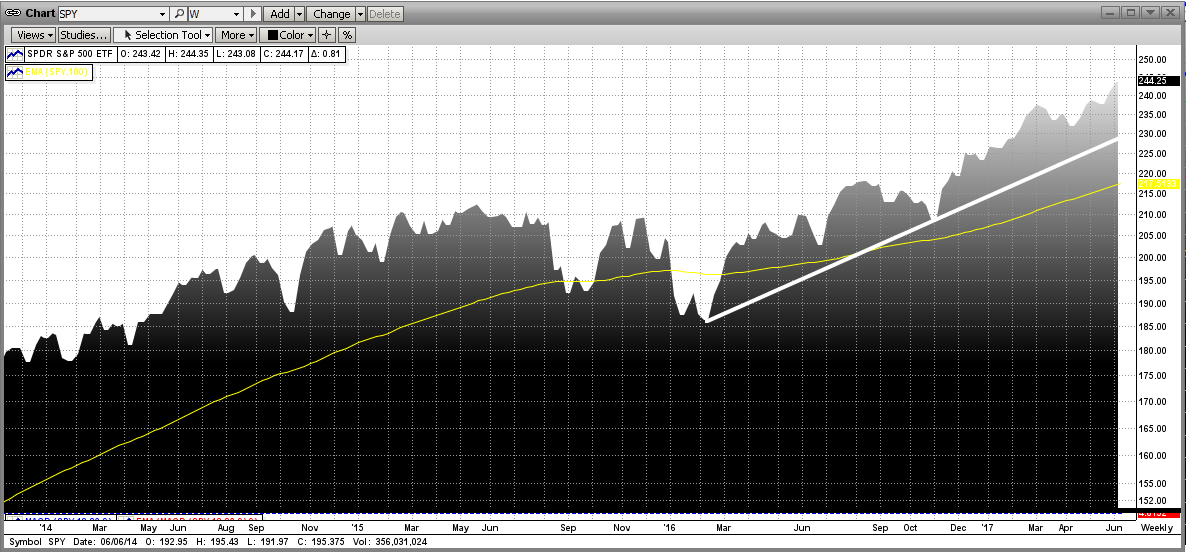
COMPOUNDING EFFECT OF LONG/SHORT TRADING IN DOWN MARKETS !!!
Good timing models should keep you Long in up markets and Short or Cash in down markets.
PLEASE remember that, if you trade an index fund (like SPY) and the market goes up for 8 or 10 or 15 months, and your model keeps you Long, your performance will be equal to (or close to equal) that of the index. One way to "better this" is to trade with a little leverage on Long signals (like 1.25x of 1.5x) and with no leverage on Short signals.
If you have a good stock market timing model (like MIPS) to tell you when to buy or short, and if you change your trading strategy from buy/hold to buy/short, you will most likely GREATLY improve your long-term investment performance. The reason, of course, is that you will be Long in up markets (making money) and Short in down markets (making money). In other words, you should make money in both up and down markets. Even though that might sound like "magic" to the average investor, the fat cats have been enjoying this type of trading (and the resulting performance) for over 100 years. They call it "Hedging".
OK, so how does buy/short actually work? Well, first you need a good stock market timing system (like MIPS3 or MIPS4) to tell you when the stock market is headed up and when it is headed down. Then, you simply need to be in long positions when the stock market is going up; and either out of the market or in short positions when the stock market is going down (simply following the MIPS Signals). That is a relatively safe market trading strategy if your timing model is a good one.
Hypothetical
Show me !!!
OK, let's look at a sample chart of stock market movements and how you would make money with the buy/short strategy. Below is how the buy/short strategy would work in a perfect world. Of course, stock market timing systems like MIPS are not perfect, but they are much, much better that going it alone.
Sample Market Performance (like in 2000-2010)

In the graphs immediately below, buy/hold & buy/short strategies would have resulted in the values at each breakpoint of those in the tables immediately below. You can see that at every breakpoint, the SPY value with buy/short "ratchets" up by being long when the market is going up, AND by being short when the market is headed down. BTW, in this hypo-example, buy/short would have grown to $350K instead of basically ending up "flat" (no gain).
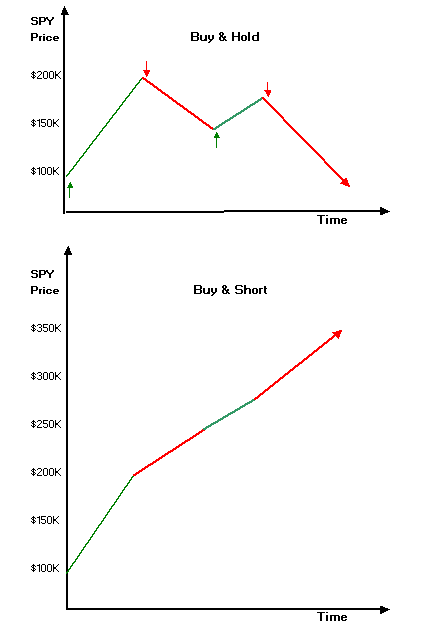
------------------------------------------------------------------------------------------------------------------------------
REAL MARKET Performance With MIPS3 (trading in 2006-2010)
Real Life Performance Using the MIPS3 Long/Short Strategy
Does the hypothetical "Buy & Short" graph above seem unbelievable? Do you doubt that this could happen in real life? It not only can, it did happen in 2000 and in 2008 (and it will happen again). For a real-life view of how MIPS performed in 2008, let's look at the period between 2006 and 2010 (using MIPS3 verified signals for this time frame from TimerTrac.com).
Buy/Hold SPY (1st Graph Below)
In this time period, the SPY
- started with $100,000,
- grew by about 27% to $127,000,
- took a nose-dive in 2008 of over 50% to $60,000,
- and grew back to where it started ($100,000) by the edd of 2010.
Big deal, 5 years and you would have ended up where you started (ie, you would not have made a penny).
Buy/Short SPY (with MIPS3) (2nd Graph Below)
The numbers in the 2nd chart below are real numbers trading with the MIPS3 buy/short strategy, using signals verified by TimerTrac.com. During the period between 12/30/2005 thru 12/31/2010, your portfolio that started at $100,000 would have grown steadily (almost no dips) over this five year period to $379,000 at the end (for a GAIN of 279%) !!! AND THAT IS REAL !!!
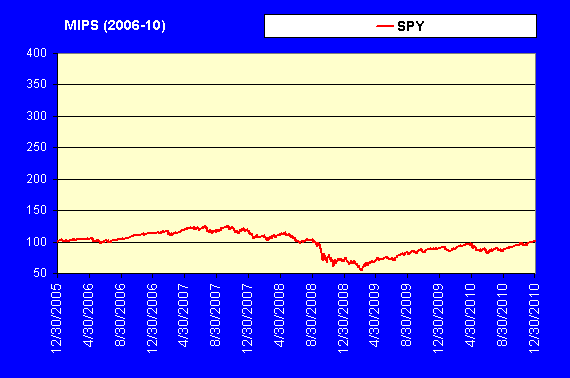

THE MORAL OF THE STORY IS:
Trading long/short effectively means that you invest with the market when it is going up and you invest AGAINST the market when it is going down (making money in down markets). Trading buy/hold means that you invest with the market when it is going up AND also with the market when it is going down (losing money in down markets)
Best Wishes !!!
Paul Distefano, PhD
CEO / Founder
MIPS Timing Systems, LLC
Houston, TX
281-251-MIPS(6477)
www.mipstiming.com
support@mipstiming.com
Sunday, May 28 2017
MIPS Members:
This week we had another market run-up on decreasing volume That is scary !!!
- stay tuned...
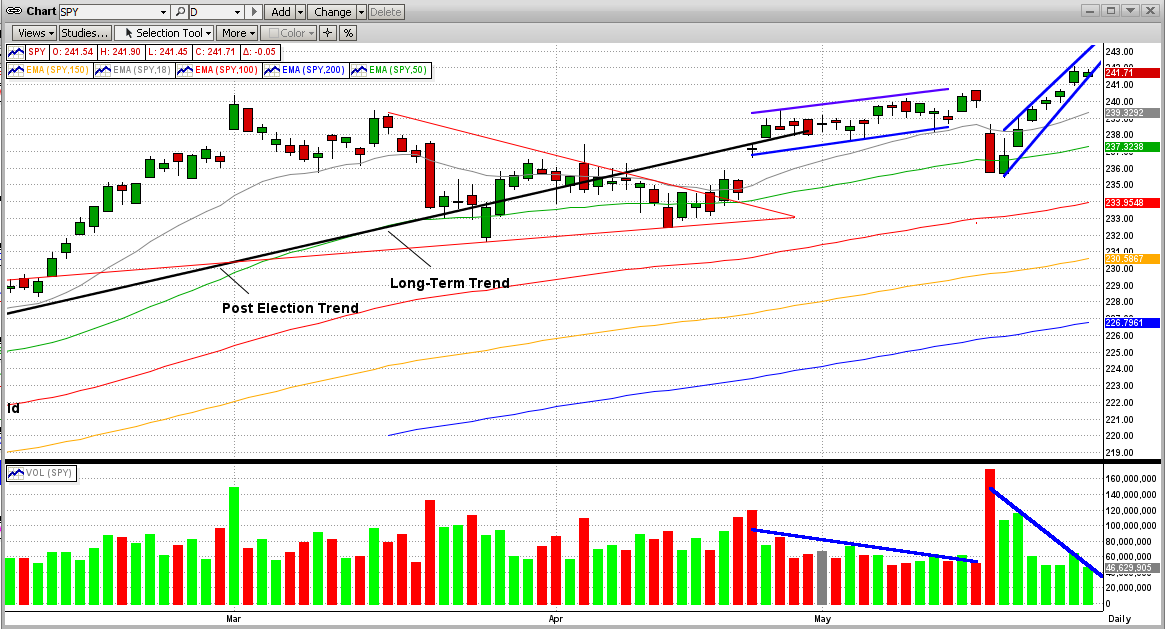
Paul Distefano, PhD
MIPS Timing Systems, LLC
Houston, TX
281-251-MIPS(6477)
==============================================================
<<< Previous email >>>
MIPS - Where and Why are the "Big Guys" Hiding? - May 20th
MIPS Members:
MIPS members who have been with us for a while know that I call large "Institutional Investors" the "Fat Kats" and/or the "Big Guys". Institutional investors include giant financial companies like Goldman Sachs, Morgan Stanley, BlackRock, State Street Global, PIMCO, etc.
How big are the Big Guys? Well there are less than 2000 Fat Kats in the US markets, but they "control" over 65% of the shares on the New York stock exchange (and most of this is controlled by the top 100). "Little Guys", like you and me and other "multi-millionaires" (haha) from all over the world that own stocks in the US markets (200 million of us), only control 35%. So, when the Fat Kats decide to get in or out of the market many of them often do so at the same time; and hence, their high volumes "move the markets". Us 200 million Little Guys, on the other hand, are not trading all day, every day like the Big Guys. This is because us Little Guys have other things to do than to "trade" - lawyers are in court, surgeons are removing someone's gizzards, engineers are launching missiles, etc. And even if a large number of us Little Guys would trade on the same day, we do not own enough shares to significantly "move the entire market".
Therefore, the Fat Kats leave a "footprint" (their daily volume). When the market goes up on high volume, we know who bought; and when the market tanks on high volume, we know who sold. They may as well send out emails saying "The Big Guys are buying" and/or "The Big Guys are selling".
For this reason, we at MIPS "adjust" the market data depending on volume. We call this Volume Adjusted Data (or VAD). Therefore, on high volume a 1% gain in the market (like in the S&P 500) may be looked upon within MIPS as a 1.5-2.0% gain; and vice versa on low volume. BTW, for the above reason, the Fat Kats wish that the total daily market volume was not published (they can't hide).
This brings us to the purpose of this Blog.
The Title is... Where and Why are the "Big Guys" Hiding?
Before we answer that, we need to explain how we know that the Big Guys are hiding and then explain why that is important.
The market has had a remarkable run to the upside since the Presidential election on Nov 11, 2017. That run was on relatively high volume. Then, the market took a break and meandered down a little until Friday, April 21st.
Now, see the relatively weak up-trend since Monday, April 24th in the graph below (blue lines).
This is NOT a good sign, because:
(a) the new up-trend is weak,
(b) the trading range is very narrow,
(c) the volatility is almost non-existent (meaning very little involvement from Fat Kats, and
(d) worst of all, the volume has tapered off to about 1/2 of its prior level, as of today (May 11th).
Read on...
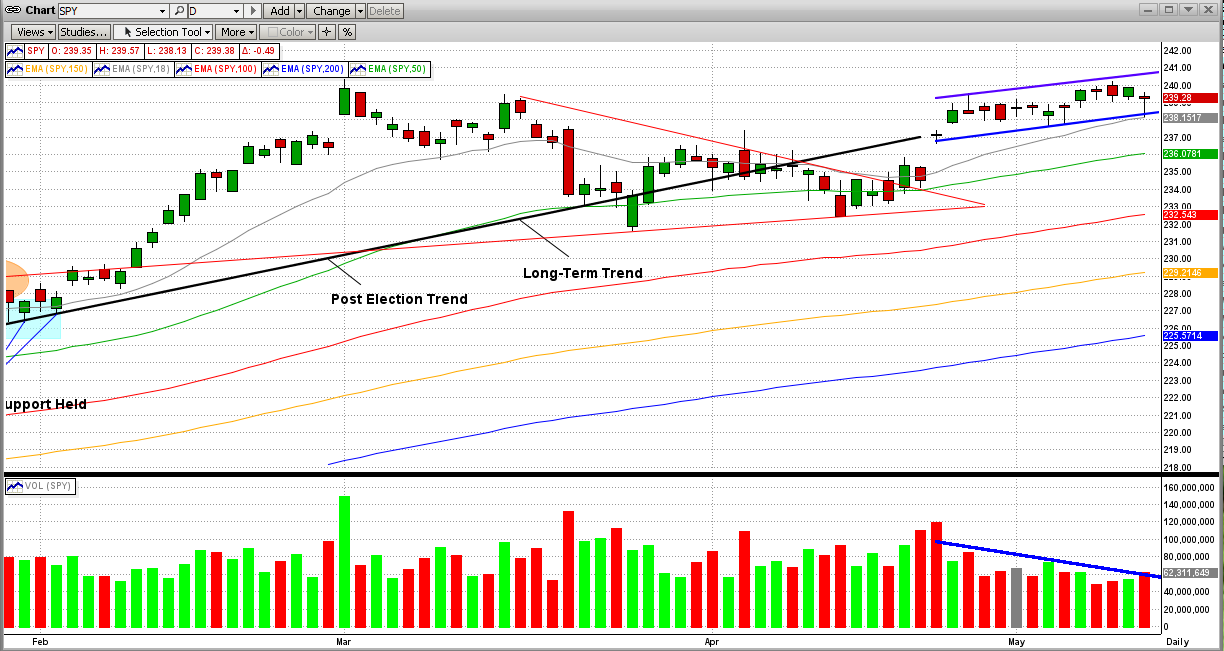
The conclusion from above is that, since the volume has basically collapsed, the Big Guys are "Hiding" on the sidelines. When markets experience very tight trading patterns on basically dried-up volume, the next move usually happens fast and moves even faster. Believe me, the Fat Kats have not packed up and gone away. The Bulls are sitting around ready to buy-in big-time at the first sign of good news; and the Bears have their fingers on the sell button, ready to sell on the first sign of bad news. In other words, the Fats Kats are playing it safe.
As you might expect, MIPS is still Long and all signs see it staying that way as long as the trend stays to the upside ("Don't fight the trend"). But, of course, that can change in a few days.
Stay tuned...
Paul Distefano, PhD
MIPS Timing Systems, LLC
Houston, TX
281-251-MIPS(6477)
Wednesday, May 24 2017
On our website at http://www.mipstiming.com/services we talk about and explain leverage and how to trade it, but we do not encourage it. On the other hand, we also do not discourage using "moderate" leverage trading for "some" investors. Of course, using leverage or not using leverage depends upon the risk tolerance of the investor. Many investors trade leverage with a just small part of their portfolio, and trade the bulk without leverage.
At any rate, we don't advise MIPS members to trade with over 1.5x leverage. BTW, you can trade 1.5x leverage for the SPY by trading 50% of your money in SPY (1.0x) and the other 50% in SSO (2.0x).
Below is a graph of MIPS3 trading various levels of leverage
- For myself, I mainly trade "Moderate Aggressive" below
- Of course, your choice is up to you
- MIPS3 is our original model with verified results all the way back to 11/04/2005
- And remember, the newest release of MIPS3 and MIPS4 (Blaster Series) are much better models
Trading SPY with various levels of leverage:
SPY with 1.5x / 1.0x (long/short) - Gold line --- Aggressive
SPY wtih 1.5x / 0.5x (long/short) - Green line --- Moderate Aggressive
SPY with 1.0x / 1.0x (long/short) - Light Blue --- *** Standard ***
SPY with 1.0x / 0.0x (long/cash) - Dark Blue line - Conservative (long-only)
SPY with Buy-and-Hold - Red Line --- Benchmark
< From TimerTrac.com >
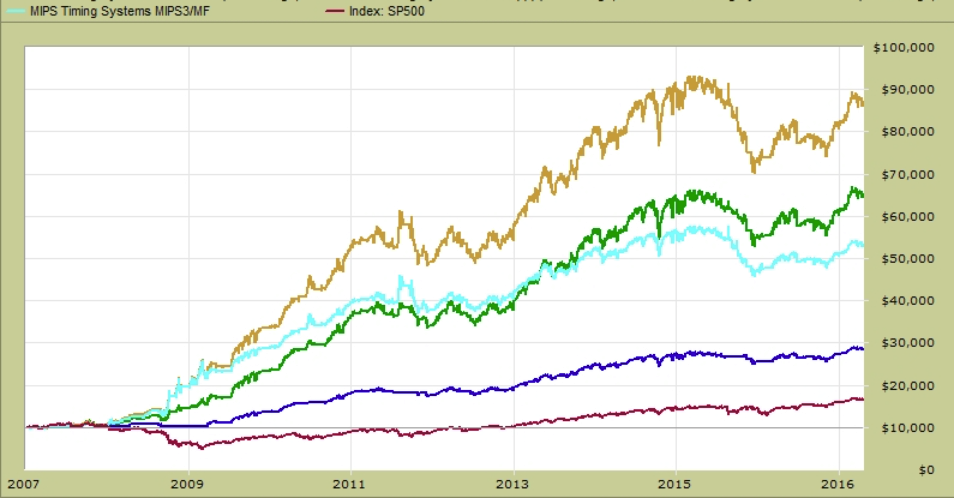
From the above, it can be seen that the Standard strategy (light blue line) grew from $10,000 => $54,000; while the SPY with buy/hold grew to $18,000.
During that same time frame, the Aggressive strategy (gold line) has the highest growth rate of all ($10,000 => $88,000), but comes with higher volatility.
A happy medium for those who want to trade with some leverage would be to trade the Moderate Aggressive strategy ($10,000 => $67,000), which out-grows the Standard strategy with lower volatility (green line).
Stay tuned...
Paul Distefano, PhD
MIPS Timing Systems, LLC
Houston, TX
281-251-MIPS(6477)
www.mipstiming.com
Thursday, May 11 2017
MIPS members who have been with us for a while know that I call large "Institutional Investors" the "Fat Kats" and/or the "Big Guys". Institutional investors include giant financial companies like Goldman Sachs, Morgan Stanley, BlackRock, State Street Global, PIMCO, etc.
How big are the Big Guys? Well there are less than 2000 Fat Kats in the US markets, but they "control" over 65% of the shares on the New York stock exchange (and most of this is controlled by the top 100). "Little Guys", like you and me and other "multi-millionaires" (haha) from all over the world that own stocks in the US markets (200 million of us), only control 35%. So, when the Fat Kats decide to get in or out of the market many of them often do so at the same time; and hence, their high volumes "move the markets". Us 200 million Little Guys, on the other hand, are not trading all day, every day like the Big Guys. This is because us Little Guys have other things to do than to "trade" - lawyers are in court, surgeons are removing someone's gizzards, engineers are launching missiles, etc. And even if a large number of us Little Guys would trade on the same day, we do not own enough shares to significantly "move the entire market".
Therefore, the Fat Kats leave a "footprint" (their daily volume). When the market goes up on high volume, we know who bought; and when the market tanks on high volume, we know who sold. They may as well send out emails saying "The Big Guys are buying" and/or "The Big Guys are selling".
For this reason, we at MIPS "adjust" the market data depending on volume. We call this Volume Adjusted Data (or VAD). Therefore, on high volume a 1% gain in the market (like in the S&P 500) may be looked upon within MIPS as a 1.5-2.0% gain; and vice versa on low volume. BTW, for the above reason, the Fat Kats wish that the total daily market volume was not published (they can't hide).
This brings us to the purpose of this Blog.
The Title is... Where and Why are the "Big Guys" Hiding?
Before we answer that, we need to explain how we know that the Big Guys are hiding and then explain why that is important.
The market has had a remarkable run to the upside since the Presidential election on Nov 11, 2017. That run was on relatively high volume. Then, the market took a break and meandered down a little until Friday, April 21st.
Now, see the relatively weak up-trend since Monday, April 24th in the graph below (blue lines).
This is NOT a good sign, because:
(a) the new up-trend is weak,
(b) the trading range is very narrow,
(c) the volatility is almost non-existent (meaning very little involvement from Fat Kats, and
(d) worst of all, the volume has tapered off to about 1/2 of its prior level, as of today (May 11th).
Read on...

The conclusion from above is that, since the volume has basically collapsed, the Big Guys are "Hiding" on the sidelines. When markets experience very tight trading patterns on basically dried-up volume, the next move usually happens fast and moves even faster. Believe me, the Fat Kats have not packed up and gone away. The Bulls are sitting around ready to buy-in big-time at the first sign of good news; and the Bears have their fingers on the sell button, ready to sell on the first sign of bad news. In other words, the Fats Kats are playing it safe.
As you might expect, MIPS is still Long and all signs see it staying that way as long as the trend stays to the upside ("Don't fight the trend"). But, of course, that can change in a few days. Stay tuned...
Paul Distefano, PhD
MIPS Timing Systems, LLC
Houston, TX
281-251-MIPS(6477)
Wednesday, April 26 2017
Whereas MIPS members who have been with us for years have seen this before, lots of "newer" MIPS members are wondering if the most recent MIPS signal (7/11/2016) is our longest ever, or maybe even if the MIPS models ever trade. Of course, they know better, but it can feel that way when a MIPS signal has a long "signal life" (like this 9-month, approximate 180 trading-day signal). {To set the record straight, the current signal is NOT the MIPS signal with the longest signal life . In the past, some have lasted well over a year. And, the MIPS3, MIPS4, and Nitro models trade an average of 12-15 times/year.}
Our previous Blog below explains why and how the MIPS signals can last for a long time (long signal life), and what causes them to change position ("trigger"). The Blog below was meant to be a general explanation, but in this blog, we would like to concentrate on the "current "signal.
To start, let's analyze the graph below.
- the white trend line shows the strength of the long-term trend (since 2012)
- the orange, pink, and blue lines show the 50-day, 100-day, and the 200-day EMA's
- the green trendlines ("fans") show the strength of the trend since our last signal (7/11/2016)
The trends of the current signal (green "fans") are as strong or stronger than the long-term trend, and the EMAs are going up nicely and are well spread-out as they should be in a typical, strong up-market. BTW, these EMAs will "bunch up" (i.e., get real close to each other) when the market finally "rolls over".
No wonder MIPS is staying Long and not going Short (or to Cash). But, not all models are like MIPS. Many short-term models tried to trade the ups-and-downs in the flat trading range below (blue box), and got whipsawed.
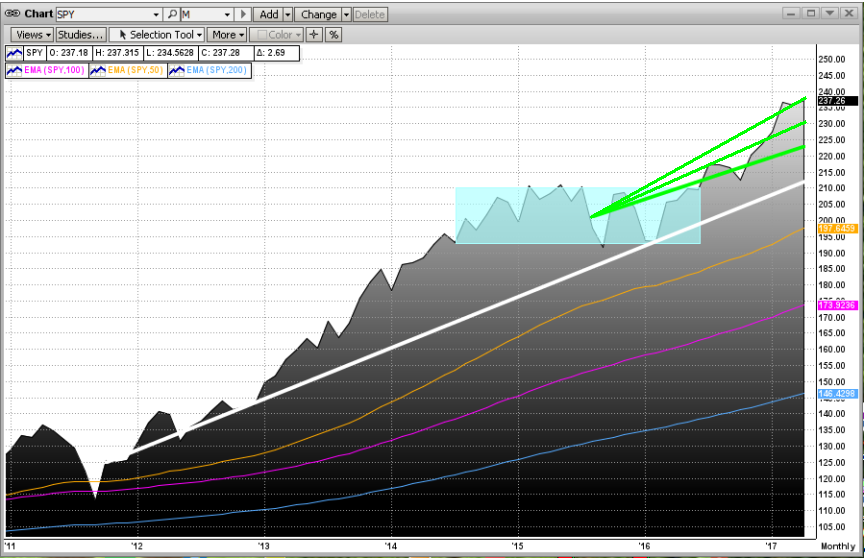
Actual Trades in 2008 and 2009
Just to support our claim that the MIPS models "trade when they should" and don't just "trade to trade", look at the actual, verified trades that the MIPS3 model issued in 2008 and 2009. Of course, this led to great gains (70% and 45%), in these two years respectively. PS - the red dots are actual trade dates.
Actual Trades in 2008 (from TimerTrac.com)
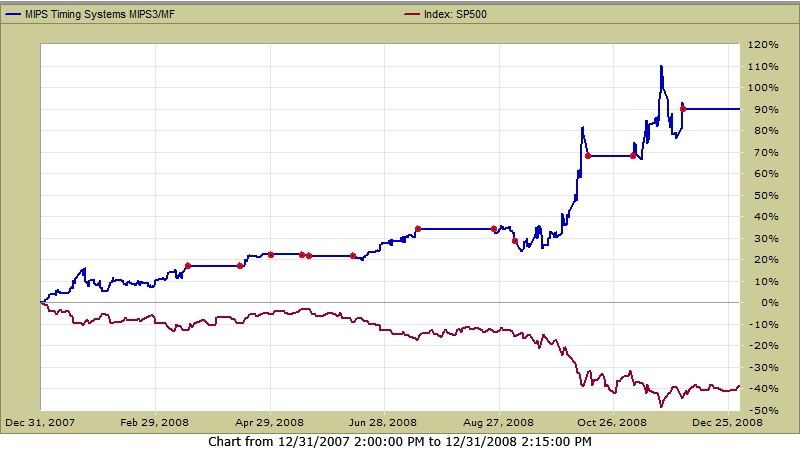
Actual Trades in 2009 (from TimerTrac.com)
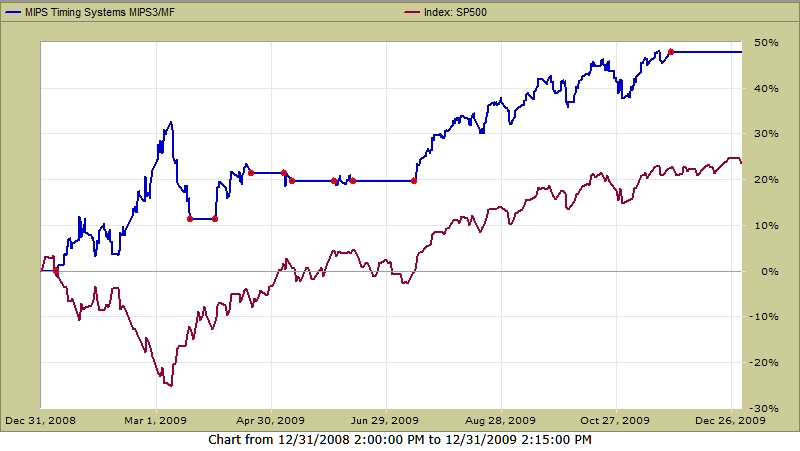
And, look at the MIPS3 Performance in 2016-2017 ytd (from TimerTrac.com)
Green - MIPS3 trading SPY 1.0x Long / 1.0x Short
Blue - MIPS3 trading SPY 1.5x Long / 0.5x Short
Red - SPY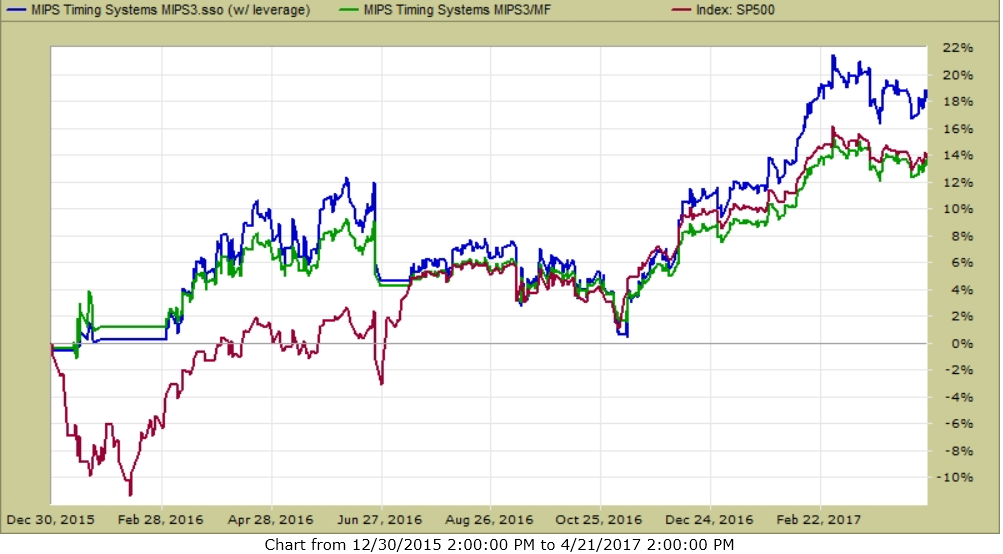
Please feel free to email or call us with questions...
Thanks,
Paul Distefano, PhD
MIPS Timing Systems, LLC
Houston, TX
281-251-MIPS(6477)
support@mipstiming.com
<<< Previous Blog >>>
April 19, 2017
Subj: MIPS - What Makes MIPS "Trigger" a Signal Change?
MIPS Members:
At almost any time, lots of MIPS members ask questions like:
1) Is MIPS getting ready to issue a new signal?
2) What makes MIPS issue a new signal?
3) How much does the market have to drop before a MIPS model issues a "Short Signal" ?
etc, etc, etc.
To understand the answer, one has to understand the concepts of some of the underlying algorithms in the MIPS models. Most "timing models" on the market today are what we would call "Linear Models", which means they basically do the same thing every time a "similar" event happens (like the SPY crossing its 200-day EMA), without regard to different external circumstances.
The MIPS models are much more "self-learning and self-predicting", which means that the MIPS models not only want to know where an indicator stands (like the SPY being above or below its 200-day EMA), but how it got there and where might it go from where it is now. A simple example of this is, if the SPY is 1% below its 200-day EMA, most models would rate this as "negative". But, the way that MIPS would look at this is, if the SPY is 1% below its 200-day EMA and it got there by falling from 6-8% above the 200-day EMA in the last 30 days or so, MIPS would look at this as negative. On the other hand, if the SPY is 1% below its 200-day EMA, BUT it got there by climbing up from 6-8% below the 200-day EMA in the last 30 days, MIPS would look at this as positive (because the "slope" or direction of the SPY is pointing up strongly).
Another, a more pertinent example of MIPS being "adaptive" and not simply doing the same thing every time a "similar" event happens, is that sometimes it takes a 5-6% move in the SPY for MIPS to trigger a new signal (like from Long to Short); but at other times, MIPS could "trigger" a new signal with a move of just 2-3%. This decision is made inside the MIPS models, and it depends upon the "relativity" of the most recent, short-term "move" in the SPY compared to the longer-term behavior of the market.
Examples
Graph #1
The MIPS models would most likely NOT go short on 4-6% drops in the SPY if the market has moved up 12-25% on a strong trend of intermediate-term cycles in the previous several months (kind of like now).
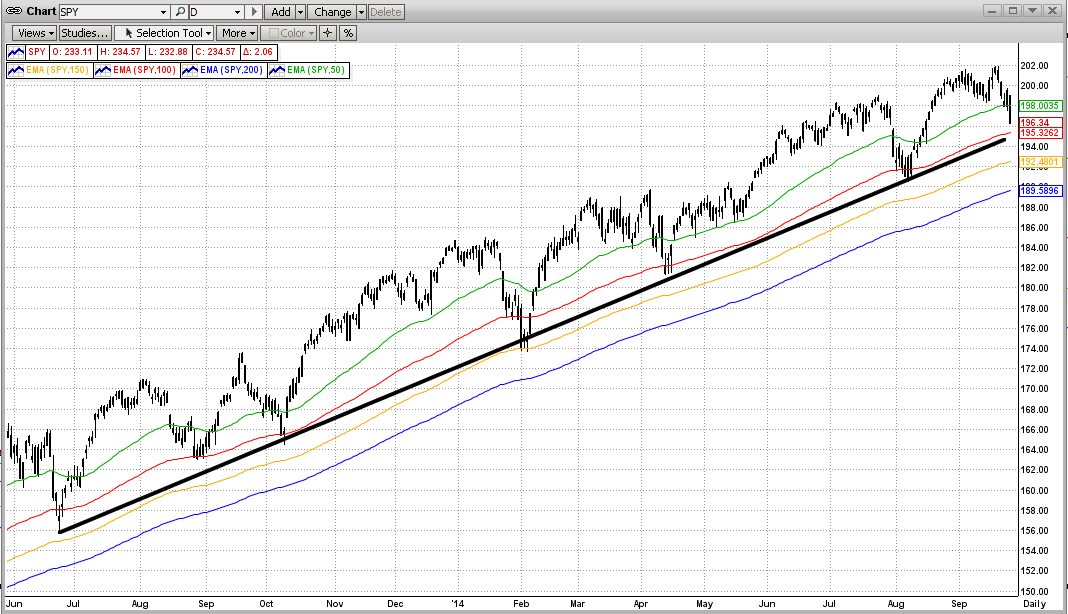
Graph #2
The MIPS models could go short on just a 2-3% drop in the SPY if the market trading range in the previous 3-4 months has been relatively flat; because a 2-3% drop is "significant" relative to the up/down volatility in a flat market. This is a very positive trait of the MIPS models because long-term market trends do not simply change direction instantly, but rather they "waffle" at the top or bottom for a several months (up to 12-15 months) before completely changing direction (called "Topping"). Note - the red and green vertical lines in the graph below show "actual" short and long signals from the MIPS3 model near the beginning of the 2008 Market Crash.
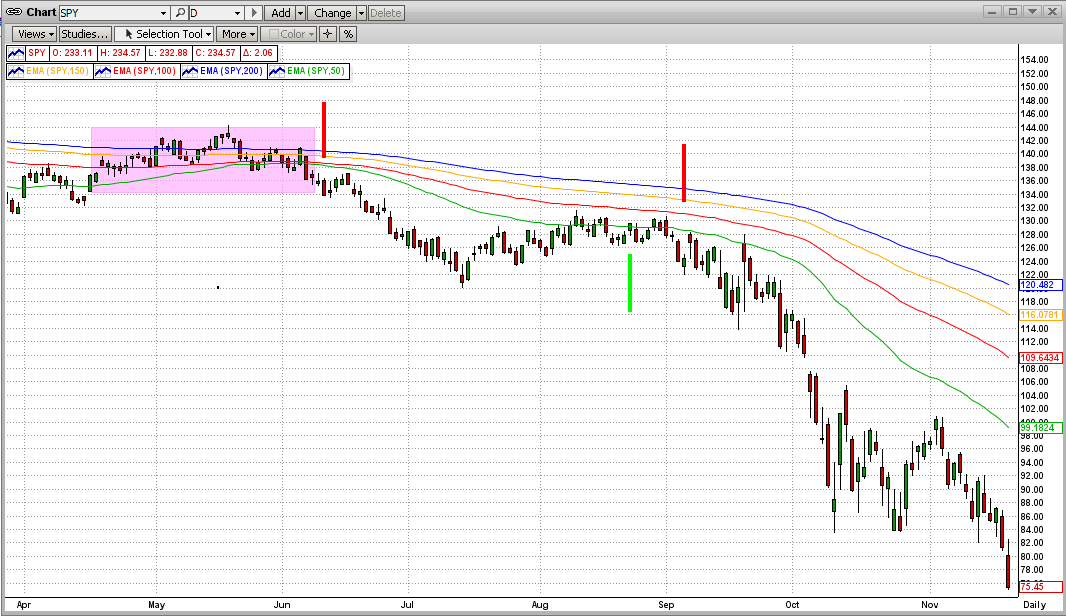
Also, please remember that the MIPS models are designed with higher-level math, pattern recognition, artificial intelligence and well over 100 standard market indicators. And, each of these have a certain "weight" in the final vote (long/short/cash). Through our "self-learning" algorithms, the "weight" of each of the above change over time, depending how accurate their "votes" were in the past. This works great for improving the performance of the MIPS models, but it makes it almost impossible for any "human" to predict the actual time or final cause of a MIPS signal change.
On average, the MIPS3 and MIPS4 models issue an average of 12-14 signals per year. The actual number of signal changes in any given year depends upon the number of times that the intermediate-term cycles change direction (as determined by the models). The MIPS models have traded 18-20 times in some years and only 3-4 times in other years. Some trends tend to go on forever (like now). Our current "Long" MIPS signal has been in effect for over 9 months now (a new record). Our main goal, of course, is making money, not just trading to be trading. Mission accomplished !!!
Please feel free to email or call us with questions...
Thanks,
Paul Distefano, PhD
MIPS Timing Systems, LLC
Houston, TX
281-251-MIPS(6477)
support@mipstiming.com
Wednesday, April 19 2017
At almost any time, lots of MIPS members ask questions like:
1) Is MIPS getting ready to issue a new signal?
2) What makes MIPS issue a new signal?
3) How much does the market have to drop before a MIPS model issues a "Short Signal" ?
etc, etc, etc.
To understand the answer, one has to understand the concepts of some of the underlying algorithms in the MIPS models. Most "timing models" on the market today are what we would call "Linear Models", which means they basically do the same thing every time a "similar" event happens (like the SPY crossing its 200-day EMA), without regard to different external circumstances.
The MIPS models are much more "self-learning and self-predicting", which means that the MIPS models not only want to know where an indicator stands (like the SPY being above or below its 200-day EMA), but how it got there and where might it go from where it is now. A simple example of this is, if the SPY is 1% below its 200-day EMA, most models would rate this as "negative". But, the way that MIPS would look at this is, if the SPY is 1% below its 200-day EMA and it got there by falling from 6-8% above the 200-day EMA in the last 30 days or so, MIPS would look at this as negative. On the other hand, if the SPY is 1% below its 200-day EMA, BUT it got there by climbing up from 6-8% below the 200-day EMA in the last 30 days, MIPS would look at this as positive (because the "slope" or direction of the SPY is pointing up strongly).
Another, a more pertinent example of MIPS being "adaptive" and not simply doing the same thing every time a "similar" event happens, is that sometimes it takes a 5-6% move in the SPY for MIPS to trigger a new signal (like from Long to Short); but at other times, MIPS could "trigger" a new signal with a move of just 2-3%. This decision is made inside the MIPS models, and it depends upon the "relativity" of the most recent, short-term "move" in the SPY compared to the longer-term behavior of the market.
Examples
Graph #1
The MIPS models would most likely NOT go short on 4-6% drops in the SPY if the market has moved up 12-25% on a strong trend of intermediate-term cycles in the previous several months (kind of like now).

Graph #2
The MIPS models could go short on just a 2-3% drop in the SPY if the market trading range in the previous 3-4 months has been relatively flat; because a 2-3% drop is "significant" relative to the up/down volatility in a flat market. This is a very positive trait of the MIPS models because long-term market trends do not simply change direction instantly, but rather they "waffle" at the top or bottom for a several months (up to 12-15 months) before completely changing direction (called "Topping"). Note - the red and green vertical lines in the graph below show "actual" short and long signals from the MIPS3 model near the beginning of the 2008 Market Crash.

Also, please remember that the MIPS models are designed with higher-level math, pattern recognition, artificial intelligence and well over 100 standard market indicators. And, each of these have a certain "weight" in the final vote (long/short/cash). Through our "self-learning" algorithms, the "weight" of each of the above change over time, depending how accurate their "votes" were in the past. This works great for improving the performance of the MIPS models, but it makes it almost impossible for any "human" to predict the actual time or final cause of a MIPS signal change.
On average, the MIPS3 and MIPS4 models issue an average of 12-14 signals per year. The actual number of signal changes in any given year depends upon the number of times that the intermediate-term cycles change direction (as determined by the models). The MIPS models have traded 18-20 times in some years and only 3-4 times in other years. Some trends tend to go on forever (like now). Our current "Long" MIPS signal has been in effect for over 9 months now (a new record). Our main goal, of course, is making money, not just trading to be trading. Mission accomplished !!!
Please feel free to email or call us with questions...
Thanks,
Paul Distefano, PhD
MIPS Timing Systems, LLC
Houston, TX
281-251-MIPS(6477)
support@mipstiming.com
Sunday, March 19 2017
We sent out the email below at 1:24am today. Since then, we have been inundated by MIPS members asking us to show the "backtested" performance results from the newest MIPS3 and MIPS4 "Blaster" models that we referred to in the last sentence in the last paragraph in the previous email below.
I.) Original - That last sentence in the last paragraph read:
"Backtesting shows that the current MIPS3 and MIPS4 "Blaster Series" models would have produced results more than three times better than the results below from our original model. And, the maximum drawdowns would have been much smaller (14% vs. 20%)"
II.) Update - As you can see in the graph immediately below, the last sentence should have read:
"Backtesting shows that the current MIPS3 and MIPS4 "Blaster Series" models would have produced results of 4 times and 5 times better (20 and 28 times their money, respectively) than the results below from our original model. And, the maximum drawdowns would have been much smaller (10% vs 20%)"
MIPS3 and MIPS4 "Blaster" from 2007 - 03/17/2017 (Bacltested)
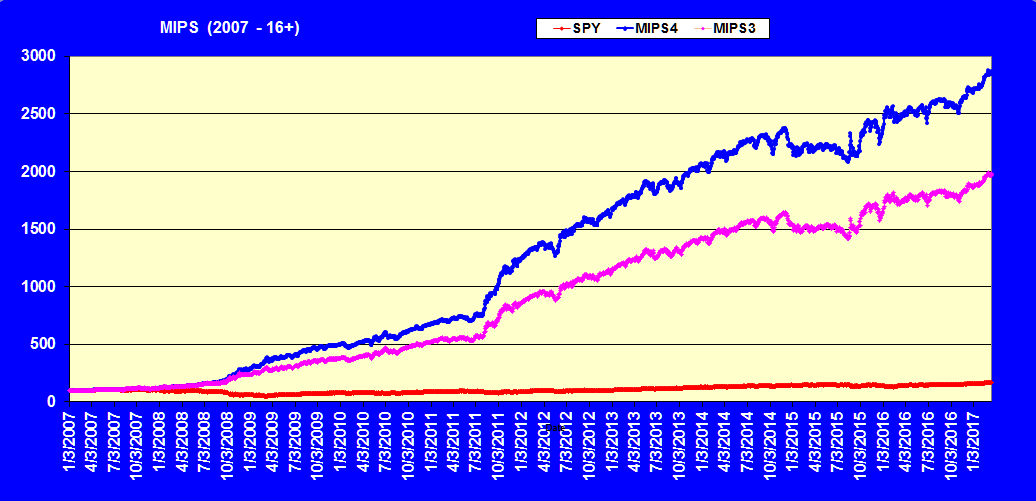
--------------------------------------------------------------------------------------------------------------------------------
Sent: Sun, 19 Mar 2017 01:24:24 -0500
MIPS Members:
As most of you know, MIPS is basically a Trend Following model, where a market "Trend" is defined as a market that either moves up over time with higher-highs and higher-lows (Up Trend), or moves down over time with lower-highs and lower-lows (Down Trend).
Technical analysts have discovered 27 cycles where identifiable trends occur. Many of these are for "Day Traders" who may trade 6-15 times a day to active traders who may trade 3-5 times a week. These would be identified as very-high-frequency traders.
We will concentrate herein on explaining the three most common (and broad) cycles that most individual analytical investors use; namely Short-Term Cycles (days-weeks), Intermediate-Term Cycles (weeks-months), and Long-Term Cycles (quarters-years). The MIPS models identify each of these trends, and trade mainly on the behavior of intermediate-term cycles (but will yield to short-term or long-term when the trend is extra strong and compelling).
Remember, the MIPS models trade between 6-15 times/year on average. But, no matter how often or how seldom a model trades, good models will almost never go against the trend (as in "Don't Fight the Trend"). So, some years the models could trade 18 times, and other years maybe only 2-4 times.
Also, please be aware that the MIPS models contain algorithms that will force themselves to abandon trend following analysis under certain conditions; such as flat-markets (trendless), compellingly over-bought or over-sold conditions (reversion to the mean), and VERY short-term cycles (to prevent getting whipsawed).
To bring this into our current conditions, please refer to the graph below. The time frame for this graph is between the market bottom in March 2009 and today. Therein, the short-term trend lines are the black ups-and-downs, the intermediate-term trend lines are green and red, and the very long-term term trend line (secular trend) is blue.
From the graph below, you can see with your own eyes that investors that stayed long the entire time from valley to peak (blue trend line) would have done well, as in 3.15 times their money from 75 to 237 in these eight years.
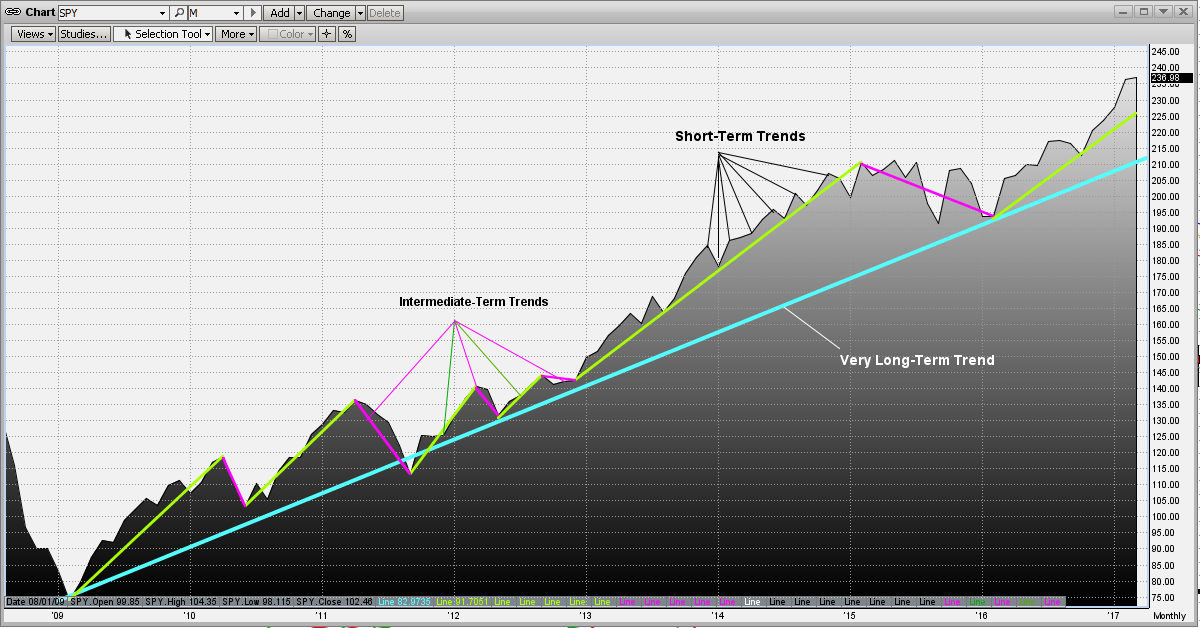
However, it is unlikely that many buy-and-hold investors would have been lucky enough to buy in at the very bottom in March 2008. Most buy-and-hold investors would have been in for a while, so how would they have done from the peak in October 2007 until now (March 2017)? For that, we will see the answer in the black trend line in the graph below. From this, it can be seen that investors would have 1.53 times their money from 155 to 237 (this is only about 1/2 of the growth from valley to peak above).
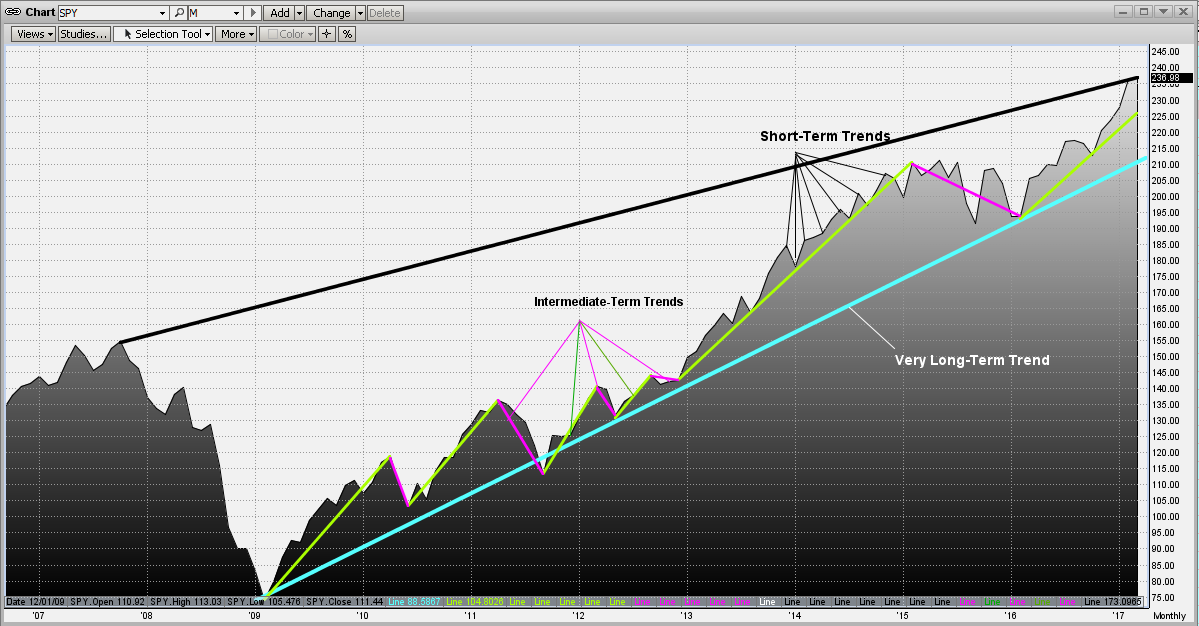
We will never know what would have happened with the short-term strategy, but we can say if the model was correct a large percent of the time, the returns would have been much higher that that above. But if the accuracy was only mediocre, investors would have gotten whipsawed and risked a large part of their portfolio.
The good news is we can show you verified results of how our "original" intermediate-term model (MIPS3) would have performed in the Oct 2007 to March 2009 time frame. For that, see the graph below from TimerTrac.com (the largest and most respected 3rd party model "tracking" company in the USA).
Investors that followed MIPS3 would have enjoyed gains of 5.20 times their money (much, much better than the 1.53 times their money from buy-and-hold). PS - Even better, these are the results from our original MIPS3 model, because it is the only one of our models that was live all the way back to 2007 (and hence has "verified" results). Backtesting shows that the current MIPS3 and MIPS4 "Blaster Series" models would have produced results more than three times better than the results below from our original model. And, the maximum drawdowns would have been much smaller (14% vs 20%)
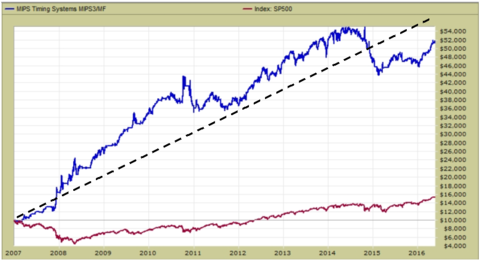
We are very proud of our MIPS models and their performances.
Paul Distefano, PhD
CEO / Founder
MIPS Timing Systems, LLC
Houston, TX
281-251-MIPS(6477)
Sunday, March 19 2017
As most of you know, MIPS is basically a Trend Following model, where a market "Trend" is defined as a market that either moves up over time with higher-highs and higher-lows (Up Trend), or moves down over time with lower-highs and lower-lows (Down Trend).
Technical analysts have discovered 27 cycles where identifiable trends occur. Many of these are for "Day Traders" who may trade 6-15 times a day to active traders who may trade 3-5 times a week. These would be identified as very-high-frequency traders.
We will concentrate herein on explaining the three most common (and broad) cycles that most individual analytical investors use; namely Short-Term Cycles (days-weeks), Intermediate-Term Cycles (weeks-months), and Long-Term Cycles (quarters-years). The MIPS models identify each of these trends, and trade mainly on the behavior of intermediate-term cycles (but will yield to short-term or long-term when the trend is extra strong and compelling).
Remember, the MIPS models trade between 6-15 times/year on average. But, no matter how often or how seldom a model trades, good models will almost never go against the trend (as in "Don't Fight the Trend"). So, some years the models could trade 18 times, and other years maybe only 2-4 times.
Also, please be aware that the MIPS models contain alogrithms that will force themselves to abandon trend following analysis under certain conditions; such as flat-markets (trendless), compellingly over-bought or over-sold conditions (reversion to the mean), and VERY short-term cycles (to prevent getting whipsawed).
To bring this into our current conditions, please refer to the graph below. The time frame for this graph is between the market bottom in March 2009 and today. Therein, the short-term trend lines are the black ups-and-downs, the intermediate-term trend lines are green and red, and the very long-term term trend line (secular trend) is blue.
From the graph below, you can see with your own eyes that investors that stayed long the entire time from valley to peak (blue trend line) would have done well, as in 3.15 times their money from 75 to 237 in these eight years.

However, it is unlikely that many buy-and-hold investors would have been lucky enough to buy in at the very bottom in March 2008. Most buy-and-hold investors would have been in for a while, so how would they have done from the peak in October 2007 until now (March 2017)? For that, we will see the answer in the black trend line in the graph below. From this, it can be seen that investors would have 1.53 times their money from 155 to 237 (this is only about 1/2 of the growth from valley to peak above).

We will never know what would have happened with the short-term strategy, but we can say if the model was correct a large percent of the time, the returns would have been much higher that that above. But if the accuracy was only mediocre, investors would have gotten whipsawed and risked a large part of their portfolio.
The good news is we can show you verified results of how our "original" intermediate-term model (MIPS3) would have performed in the Oct 2007 to March 2009 time frame. For that, see the graph below from TimerTrac.com (the largest and most respected 3rd party model "tracking" company in the USA).
Investors that followed MIPS3 would have enjoyed gains of 5.20 times their money (much, much better than the 1.53 times their money from buy-and-hold). PS - Even better, these are the results from our original MIPS3 model, because it is the only one of our models that was live all the way back to 2007 (and hence has "verified" results). Backtesting shows that the current MIPS3 and MIPS4 "Blaster Series" models would have produced results more than three times better than the results below from our original model. And, the maximum drawdowns would have been much smaller (14% vs 20%)

We are very proud of our MIPS models and their performances.
Paul Distefano, PhD
CEO / Founder
MIPS Timing Systems, LLC
Houston, TX
281-251-MIPS(6477)
|